Welcome Message

Welcome to the Department of Mechanical Engineering at IIT Kanpur. We started our journey in the year of 1960. Over the last six decades, we have grown our expertise and competence in the core Mechanical Engineering curriculum and research....
- Read More
-Prof. Ashish Dutta
Head, Department of Mechanical Engineering
Announcements
Teaching Laboratory
ME 222: Nature and Properties of Materials
Overview:
Objective is to give a broad understanding of common materials related to mechanical engineering with an emphasis on the fundamentals of structure-property-application relationships.
Course Content:
History of engineering materials, Engineering materials, Materials property chart, Crystal structure, Imperfections of solids, Mechanism of strengthening in metals, Hall-Petch effect, Xray diffraction, Fracture: Ductile, brittle, fatigue. Griffith criterion, S-N curve, Creep, Phase diagram (binary), Iron-carbon system, Heat treatment of metals, Electrical properties, Thermal properties, Magnetic properties, Optical properties, Corrosion, Oxidation, Thermal stability ,
Wear, abrasion, friction of materials, Characterization techniques: Optical microscopy, scanning electron microscopy, transmission electron microscopy, atomic force microscopy, Polymer and its characterization, Viscoleasticity, Nanomaterials and its important properties at nanoscale, Composites: Characterization of composites, Ionic polymer matrix composites, Shape memory alloy, Intelligent Multifunctional materials, Economics, Environment, and
Sustainability In addition to the lectures, the course is associated with a laboratory session. A group of 6/7 students can conduct experiment effectively. A total of six experiments for the duration of 2 hours each is proposed for this course.
Processing Equipment:
Environmental Controlled High Temperature Furnace: Heat treatment in controlled atmosphere
Specification:
Temperature: Room temperature to 1400 0C
Heating rate : 0.5 0C/min to 10 0C/min
Environment : Air, Nitrogen, etc
Location: ACMS 207B

Processing Equipment:
Specimen Cutting Machine- Metallic, polymer, etc
Specification:
RPM- 1500 max
Wheel size: 33 x 2 x 32 mm
Sample size (max): 30 mm x30 mm
Location:ACMS 203B

Processing Equipment:
Single/Double Disc Polishing Machine- Polishing of samples to get smooth surface finish
Specification:
Diameter of disc: 200 mm
Rotation: 300-650 rpm
Location: ACMS 203B

Characterization Equipment:
Universal Testing Machine- Studies of strain-strain behaviour of materials
Specification:
Max force- 100 kN
Cross head speed- 5 mm/min to 100 mm/min
Travel length- 450 mm
Test types- Tension, Compression, and Flexural
Location: NL-1, Room # 112

Characterization Equipment:
MTS 810 Testing Machine- Studies of mechanical properties of materials
Specification:
Max. Force- 100 kN
Travel length- 1308 mm
Controller: Flex test 40
Test types: Tension, compression, bending, and cyclic fatigue
Location: NL-1, Room # 112

Characterization Equipment:
Rotating Beam Fatigue Tester: Studies of fatigue life and endurance limits of metals
Specification:
Load- 10 Kg to 40 Kg
RPM – 1420
Location: ACMS, Room # 207B

Characterization Equipment:
Rotating Beam Reverse Bending Fatigue Testing Machine- Studies of fatigue life and endurance limits of metals
Specification:
RPM- 2800 - 6000
Load- 0.5 kg – 4 Kg
Sample- Dumbbell shape
Diameter of specimen: 8 mm
Location: ACMS 207B

Characterization Equipment:
Rotating Beam Reverse Bending Fatigue Testing Machine - Studies of fatigue life and endurance limits of metals
Specification:
Diameter of test specimen: 8 mm Maximum bending moment: 500 Kg. cm.
RPM- 1425
Load- 0.250 Kg to 50 Kg
Location: ACMS 207B

Characterization Equipment:
Shore A Durometer- Measurement of hardness for soft materials like rubber
Specification:
Preload: 0.45 Kgf
Major Load: 8.06 N
Indentor type- 35° truncated cone indenter
Type of load- Constant contact pressure
Location: ACMS 207B

Characterization Equipment:
Shore D Durometer- Measurement of harness for hard polymer
Specification:
Preload: 0.45 Kgf
Major Load: 44.48 N
Indentor type- 30° cone indenter
Type of load- Constant contact pressure
Location: ACMS 207B

Characterization Equipment:
Portable Hardness Tester- Rockwell hardness tester for measurement of hardness
Specification:
Rockwell test
Load – 10 Kg, 60 Kg, 100 Kg and 150 Kg
Indentor: Diamond /
1/16” ball
Location: ACMS 207B

Characterization Equipment:
Poldi Hardness Tester- Measurement of hardness
Specification:
Preload: 0.42 Kgf
Major Load: Hammer blow
Material - Alloy steel EN-8 OR EN-9
Dia- 30mm
Length- 85 mm
Tungsten Carbide Ball
Dia- 10 mm
Poldy Bar
Material: Alloy steel EN-8 or EN-9 or Carbon Steel- WPS
Size- 12 mm X 12mm X 150 mm
Eyepiece- 8X, 25 X
Location: ACMS 207B

Characterization Equipment:
Ellipsometer- Thickness of thin film
Specification:
Range: 10 nm – 400 nm
Source – Green laser, 532 nm
Location: ACMS 203F

Characterization Equipment:
Metallography Station Trinolcular Optical Microscope with Camera- To study surface morphology
Specification:
Magnification- 25 X to 1200X
Focusing: Coarse to fine
Head: Monocular, binocular/trinocular
Illumination- Halogen, incident light
Eye piece: 5X, 10X, 15X and 20 X
Objective: 5X, 10X 20X and 40X
Location: NL-1, Room # 112

Characterization Equipment:
Surface Roughness Tester- Measurement of surface hardness
Specification:
Range: 350 m (-200 m to 150 m)
Detecting mode: Skid measurement
Measuring force: 4mN or 0.75 mN (Low force type)
Stylus tip: Diamond, 900/mR (600/2mR: low force type)
Travelling length : 6 mm
Evolution length (mm) : 1.25, 4.0
Location: ACMS 207B

Characterization Equipment:
Superficial Rockwell Tester
Specification:
Range: 350 m (-200 m to 150 m)
Detecting mode: Skid measurement
Measuring force: 4mN or 0.75 mN (Low force type)
Stylus tip: Diamond, 900/mR (600/2mR: low force type)
Travelling length : 6 mm
Evolution length (mm) : 1.25, 4.0
Location: ACMS 207B

Characterization Equipment:
Brinell Hardness Tester- Brinell hardness test of Metals
Specification:
Preload: 250 Kgf
Major Load - 250-3000 Kgf in range of 250 Kgf
250, 500, 750, 1000, 1250, 1500 Kgf
Maximum test height- 410 mm
Depth of throat- 205 mm
Max depth of spindle below base – 180 mm
Steel ball diameter (Indentor)- 10 mm , 5 mm, 2.5 mm
Location: ACMS 203B

Characterization Equipment:
Vickers Hardness Tester- Vickers hardness tester of metals
Specification:
Load- 5 Kgf to 50 Kgf
30, 40, 50 Kgf (loads 5, 10, 15, 20 not working properly)
Indentor – diamond
Magnification- 25 X
Location: ACMS 203B

Associate Faculty: Prof. Kamal K. Kar, Prof. Bishakh Bhattacharya, Prof. J. Ramkumar
Staff: Mr. Suresh Chendra
Contact Person: Mr. Suresh Chendra
Career options for aspiring mechanical engineers
Practically every company that designs and produces a product employs a mechanical engineer. But mechanical engineers can also be found in research labs, the military, government, and in other professions such as management, finance.
Diverse Job Profiles of our Graduates
Most mechanical engineering jobs require design experience. A second major area of employment for mechanical engineers is manufacturing. Manufacturing jobs cover nearly everything involved in developing a product, from selecting the appropriate materials to choosing the correct machinery to manufacture the product. Most mechanical engineers in this industry work for equipment manufacturers, aerospace companies, utilities, material processing plants, transportation companies, and petroleum companies.
Specific assignments might involve research and development, design of equipment or systems, supervision of production, plant engineering, administration, sales engineering, the testing and evaluation of machines and entire plants. Mechanical Engineers are needed in automobile, biomedical, cement, chemical, mining and metallurgy, nuclear, power plant, robotics, heating, ventilation, and air conditioning (HVAC) industries.
Mechanical engineers can find employment at virtually any institute where innovation takes place. They commonly work in the government, research, industry, military, teaching, management or consulting sectors. With a degree in mechanical engineering, diversity is the key. You can wind up working in a laboratory or an outdoor construction site. Remember, nearly every mechanical device was created by a mechanical engineer so the possibilities for employment are virtually endless!
We have an excellent student placement statistics.
Year (2009 - 2010 )
| Program | Registered | Placed | Percentage |
| B. Tech. | 40 | 36 | 90% |
| Dual Degree | 16 | 16 | 100% |
Year (2010 - 2011)
| Program | Registered | Placed | Percentage |
| B. Tech. | 30 | 29 | 97% |
| Dual Degree | 21 | 19 | 90% |
Year (2011 - 2012 )
| Program | Registered | Placed | Percentage |
| B. Tech. | 44 | 33 | 75% |
| Dual Degree | 22 | 22 | 100% |
Year (2012 - 2013 )
| Program | Registered | Placed | Percentage |
| B. Tech. | 39 | 32 | 87% |
| Dual Degree | 23 | 21 | 91 |
Year (2013 - 2014 )
Will be updated soon...
| Program | Registered | Placed | Percentage |
| B. Tech. | |||
| Dual Degree |
Undergraduate research has grown to levels of sophistication today. Virtually, every university that is active in research has grown to understand the importance of research to be inculcated from the early days. In Mechanical Engineering department, besides teaching our experienced faculty members actively participate in undergraduate research program. Undergraduate research is a pedagogical tool that helps channelize the energy and enthusiasm of students into conceptual-based education, thereby igniting their minds to explore with curiosity the world around them. It can help students to
- Abridge the gap between class-room education and real world challenges, and learning the relevance of the curriculum that they undergo at the Institute, and
- Internalize and take ownership of the process of learning and education.
Thus, undergraduate research is seen as a vehicle to bring about a change in the approach of addressing the holistic development of undergraduate students at this Institute. It offers valuable experiences and benefits to all sections of the academic environment - students, mentors as well as the Institute.
SURGE Program
Under the Summer Undergraduate Research Grant for Excellence (SURGE) program, undergraduate students from IITK and other participating institutions undertake short duration, but focused research projects and push their intellectual abilities beyond those driven by the classroom.
A quantitative deliverable at the end of the 10 week program is the technical paper written by the student in association with the mentor(s). The acceptance of this paper by a refereed journal is one measure of the success of the undergraduate research. More valuable outcome, but difficult to quantify, is the personal and professional development of student. They also develop specific laboratory skills and research methodology. The impact of participation in undergraduate research will become obvious at a subsequent occasion, e.g., when the student chooses to go for graduate studies. Students will find themselves better prepared and equipped to make conscious career choices, because self-discovery during undergraduate research helps students realize one's strengths and choices.
SURGE overseas program for IITK students:
In this program, IITK students are given a unique opportunity to spend eight weeks of the summer at a prestigious overseas university. Interested students need to complete an online application form. In addition, two letters of recommendation are needed. For more details, follow the url: www.iitk.ac.in/surge
SURGE program for IITK students at IIT Kanpur:
In this program, IITK students are given an opportunity to work with a chosen mentor at IITK. In order to complete the application, it is necessary for the student to identify a professor who agrees to be his/her mentor during the summer period, and a suitable project to pursue for the eight weeks in summer.
The undergraduate programs have two components. The first component is the core program common to all students and is carefully planned to give the students a solid foundation of general education in Mathematics, Physics, Chemistry, Engineering Sciences, Technical Arts, and Humanities and Social Sciences. Besides these courses, students also undertake courses in Introduction to Mechanical Engineering, Mechanics of Solids, Nature and Properties of Materials, Thermodynamics and Fluid Mechanics in the first four semesters of the B.Tech program. Some of these courses are complemented by laboratory and project work. The course structure in the core curriculum provides for large lecture classes with tutorial discussion hours and laboratory sessions in smaller groups.
The second component of the undergraduate program includes professional courses and a project in the chosen branch of specialization. In the last four semesters, students undertake some core mechanical engineering courses in Design of Machine Elements, Dynamics and Vibration of Machinery, Manufacturing Technology, Heat and Mass Transfer, Energy Systems, etc. An important feature of our undergraduate program is the availability of large number of elective courses which provides the students considerable freedom to develop academically according to their individual tastes. These courses are often designed to advance the fundamental understanding, introduce new concepts and technologies pertinent to the industries and academia.
Summer Internship
Students also undergo compulsory summer training during the B.Tech program, which helps them to visit and learn from the leading Indian and foreign industries/academia.
Students Projects
In the final two semesters of the program, students undertake an advanced design project, which involves the application of modern analysis and design techniques. Often the student projects translate in a development of new product and technology, leading to patent or other type of publications.
Assessment
Assessment can vary from course to course and can include a combination of class work, tutorials, assignments, laboratory work, quizzes, project work and exams.
Complete Undergraduate Curriculum of Mechanical Engineering is available here.
Teaching Laboratory
ME 361A: Manufacturing Technology
Overview:
Objective of this course is to give a broad understanding of conventional and non-conventional machining processes with an emphasis on the characterization techniques. This course also familiarizes students with the scientific principles governing various machining processes.
Equipments
- On Lathe- Lab VIEW Software, Three-component piezo-crystal type dynamometer make Kistler, NI DAQ Card, Microbalance, Dinolite USB Microscope, Vernier Calliper e.t.c.
- On Grinding- Lab VIEW Software, Three-component piezo-crystal type dynamometer make Kistler, NI DAQ Card, Microbalance, Dinolite USB Microscope, Portable Surface Roughness Measuring Instrument etc.
- On EDM – Electronica ZNC EDM Machine, Microbalance, Shadowgraph/ USB Microscope, Micrometer, Stopwatch, etc.
- On Hydraulic Press- USB Microscope, Load Cell, Lab VIEW Software, NI DAQ Card, Vernier Calliper, Proving Ring etc.
- On Microchannels fabrication- Microbalance, USB Microscope, Dessicator, vacuum pump, Furnace temperature upto 400 degree centigrade etc.
- On Milling- Multi-component dynamometer make Kistler, Labview software, NI DAQ Card, Dinolite USB Microscope, Vernier Calliper, Microbalance etc.
Experiments:
- To measure the cutting force, tool temperature and shear angle during orthogonal cutting (on Lathe).
- To study the effects of grinding variables on grinding forces, specific energy and surface finish.
- To study the EDM machine and determine material removal rate and tool wear rate during machining of EN8 steel.
- To draw a cup by cup drawing process and measure the drawing force on hydraulic press.
- To fabricate micro channels through micro Replication double inversion technique.
- Investigation of wear and cutting processes (Fx, Fy, Fz and Mz) near the tool age during milling and drilling by Rotating 4-Component Dynamometer (RCD) on EMCO Mill concept 250.
- To obtain the measurement of a given component using coordinate measuring machine (CMM).
- To fabricate micro channel through epilog laser fiber mark fusion engraving machine.
- To measure the axial force, with tool speed for different diameters, if the feed is constant on HMT Radial Drill Machine.
- To obtain the measurement of roundness of a given component using Out of roundness measuring machine (Mitutoyo, Japan)
- To measure the cutting force, shear angle during orthogonal cutting, cnc programming (Absolute/Incremental) and operations on flat bed Simple Turn5075 ACE Designer CNC Lathe Machine.
- To study the various features of surface roughness measuring instrument also measure the parameters of the specimen.
- To study the integrated multi process (µ-milling, µ-turning, µ -drilling, µ-EDM, µ-ECM, µ-wire cut, µ-EDG) on micromachining machine DT-110.
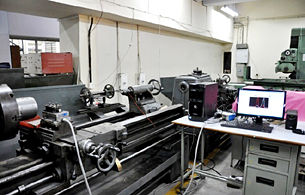
HMT LB-25 Centre Lathe:
Specification:
HMT LB-25 LATHE 500mm SWING x 2000mm BETWEEN CENTRES. 18 SPEEDS 32-1600 RPM. 52mm SPINDLE BORE WITH 3 JAW CHUCK, 4 JAW CHUCK, FACE PLATE, MULTIFIX QUICK CHANGE TOOLPOST.
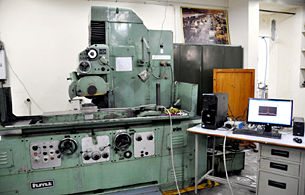
Horizontal Surface Grinding Machine
Make: HMT
Model: SFW1
Magnetic Chuck Size: 1000mm x 300mm
Accuracy: 2 μm
Table speed: 2.5, 5, 10, 15, 20, 25 (m/min)
RPM: 1500
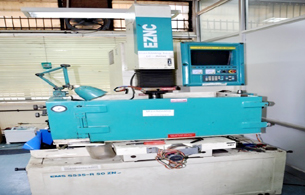
Electronica R50# ZNC
Work tank : 800 x 500 x 350 mm
Work table size: X Y Z : 300 x 250 x 200 mm
Programmable Z axis control, manually operated x and y axis.
Accuracy: 5µ
99 programs, 50 steps per program
Max. working current: 50A
Gap voltage: 100-270V
Max. Stock removal (cu-steel): 300(cu.mm/min)
Best surface finish: 0.5µ CLA
Electrode wear: 0.3-20%
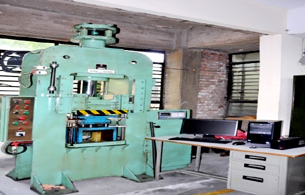
Processing Equipment:
SPECIFICATION:
Make : Fluid Power
Type : Hydraulic
Bed Size : 500 mm x 500 mm
RAM Dia. : 12 mm"
Capacity : 10 T

SPECIFICATION:
Model/Make: EMCO Concept Mill 250
Max Speed: 10,000RPM, Power 7KW
20 Station Tool Drum with directional logic
Travel- X350mm, Y250mm, Z300mm
Clamping Surface- 500x300mm
PC Controlled CNC –Machining center with Interchangeable control
EMCO Software Win NC
SINUMERIK 810/840D machine license (32bit)
Software EMCO 3D View
4th Axis- NC Dividing Head WALTER TANI 80 NEG
5th Axes- Turntable DSE25 èSpindle Speed A axis 15rpm; Spindle Speed B axis 3rpm; Size- X/Y/Z = 520/260/150; Swiveling Height =80MM; Swiveling Area of 4th Axis = Max. ±91o
ESPRIT CAM Software è Powerful Spectrum Programming for
2-5 Axis Milling,
2-22 Axis Turning, 2-5 Axis Wire EDM,
Multitasking Mill Turn Machining,
Swiss Turn and B-Axis Machine Tools High Speed 3 and 5- Axes Machining.

Coordinate Measuring Machine
Model: - Spectra 5.6.4. CNC
Scale Regulation = 0.5 μm
Machine accuracy = (± 2.5 + L/250) μm; (L: Standard length in mm)
Angular accuracy = 1” (One second)
Granite flatness = 2 micron per meter square
Granite grade = zero grade
Probing system = MS2DI
M/c version = CNC version
M/c working volume = X = 500 mm; Y = 600 mm; Z = 400 mm
Controller name = Renishaw UCC (Universal CMM Controller) lite-2 (U.K.)
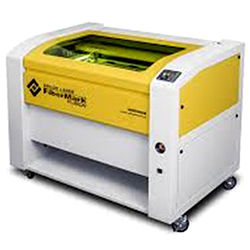
Processing Equipment:
Epilog FiberMark Fusion
Size (W x D x H): 52.5" x 33.5" x 40.75"
(1334 x 851 x 1035 mm)
Engraving Area: 32" x 20"
(812 x 508 mm)
Focal Length (F-Theta Lens): 5" (127 mm)
Maximum Material Thickness: 11.25" (285 mm)
Laser Wattage 20, 30, or 50 watts
Laser Type: Solid State Pulsed Ytterbium Fiber Laser (air cooled)
Mode of Operation: Pulsed 20-80 kHZ.

Processing Equipment:
Hindustan Radial Drill Machine
Specification:
Make : HMT
Model : RM61
Spindle Capacity : 60 mm
Arm Length : 1200mm
RPM : 40,56, 80, 112, 150, 220, 300, 440, 580,
850, 1160, 1700

Characterization Equipment:
Mitutoyo RA-116 Round Test
Specification:
• Measuring and analysis software package ROUNDPAK running under Windows operating system
• Air-bearing turntable for high precision, wear-free rotation
• Accepts workpieces up to ø17.32" (440mm) diameter
• Turntable loading 20 kgf maximum
• Measurable diameter ø11.02" (280mm)
• Measuring range ±1000μm
• Measuring height for outside/inside diameters: 11.02" (280mm) maximum
• Measuring depth inside 3.94" (100mm) maximum (with standard stylus)
• Traverse of R axis 6.5" (165mm)
• Large centering range ±.12" (±3mm)
• Large levelling range ±1°
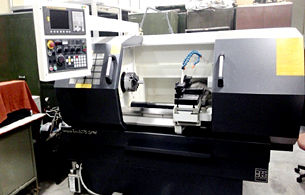
Processing Equipment:
ACE MAKE FLAT BED CNC LATHE MACHINE MODEL SIMPLE TURN 5075 WITH FANUC Oi MATE –TD CONTROL
Specification:
Swing Over Bed: Ø500
Swing Over the cross slide: Ø220
Maximum Turning Length : 650mm
Distance between Centers: 750mm
Spindle speed: 0-4000rpm
Spindle Motor Power: 11/7.5KW
LINEAR TOOLING
X Axis: 300mm
Z Axis: 700mm
Tailstock Quill Travel 180mm
Quill Taper: MT-5

Characterization Equipment:
Surface Roughness Measuring Instrument Specification:
Model SJ–301, Make: Mitutoyo
Measuring range
Z-axis 350 μm
X-axis 12.5 mm
Drive Unit Measuring: 0.25 mm/s; 0.5 mm/s
Speed Returning: 1.0 mm/s
Standard Probe (178-395)
Measuring Method Induction method
Stylus Diamond Tip: Radius 2 μm
Measuring Force 0.75 mN
Parameters: Ra, Rq, Rz
Cut-off-Length: 0.08 mm, 0.25 mm, 0.8 mm,
2.5 mm, 8 mm
Sampling Length: x 1, x 3, x 5, x L

Processing Equipment:
Mikrotools DT-110
Specification:
Work Table: 440 X 320
X & Y Axis Travel: 350 X 270
Z Axis Travel : 320+300
Max weight of the work piece: 350 kg
Work tank: 800 X 480mm
Connected load: 2 KVA
Max matching current: 20 amp.
Machine Footprint: 950 X 770 X 1950
Accuracy: 0.1 μm (100nm).

Characterization Equipment:
Dino-Lite Premier USB Microscope
Specification:
Model: AM7013MZT4 Dino-Lite Premier
Interface: USB2.0
Resolution: 5Megapixel
Magnification Range: 20x-250x
Sensor: Color CMOS
Save Formats:
Image: BMP, GIF, PNG, MNG, TIF, TGA, PCX, WBMP, JP2, JPC, JPG, PGX, RAS, PNM DinoXcope: PNG, JPEG
Movie: WMV, FLV, SWF
DinoXcope: MOV
Polarizer and Measurement Function

Characterization Equipment:
3-Component Dynamometer
Specification:
Dynamometer with handy size. Built-in charge amplifier with 4 measuring ranges switchable. Simple operation with control unit Type 5233A1.
Type 9257BA
External control unit for range selection and reset/operate. Signal output with 3 x BNC neg. and D-Sub 37-pin.
Type: piezo-crystal
Forces: Fx, Fy and Fz with four miniature
Range: Fx and Fy 500N to 5KN
Fz: 1KN to 10KN
.jpg)
-2.jpg)
Rotating 4-Component Dynamometer (RCD)
Specification:
Make: KISTLER
Dynamometer Type 9123C
The dynamometer consists of a four component sensor fitted under high preload between a baseplate and top plate. The four components are measured practically without displacement.
Rotating 4-component dynamometer for measuring of cutting forces and torques on the rotating tool spindle. Transmission of measured data by telemetry hence without wear.
Speed 1/min max. 10 000
Range 1 FSO Fx, Fy kN –5 ... 5
–3 ... 3
Fz kN –20 ... 20
Mz Nm –200 ... 200
Range 2 FSO (switchable) Fx, Fy N –500 ... 500
Fz kN –2 ... 2
Mz Nm –20 ... 20
Sensitivity (Range 1) Fx, Fy mV/N ≈ 2
Fz mV/N ≈ 0,5
Mz mV/Nm ≈ 50
Forces: Fx, Fy, Fz and Mz
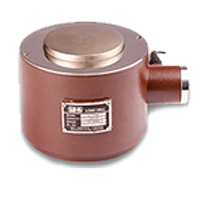
Characterization Equipment:
Column Load Cell
Specification:
Make: IPA
Model: FC074H0
Type: Stain gauge based
Capacity: 70Ton
Gauge Resistance: 350 ohms nominal
Exitation voltage: 10v DC
Sensitivity: 1.5mV/V
Safe overload: 150% of rated load.
Resolution: 50Kg

Characterization Equipment: Microbalance
Specification:
Make: CITIZEN
Model: CY204
Capacity x Resolution (g): 220 g x 0.0001 g
Repeatability: 0.0001 g
Linearity: 0.0002 g
Response Time: 2 - 3 seconds
Units: g, mg, ct, GN, mo, oz, dwt
Platform Dimensions: 3.5" diameter
Sensor Type: Electromagnetic Force Compensation

Proving Ring
Specification:
Make: HEICO
Model: PR-302
Capacity: 5KN
Dial Gauge: ASAHI
Calibrated in: Compression
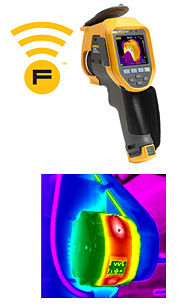
Fluke Ti400 Infrared Camera
Specification:
Make: FLUKE USA
Model: TI-400
Temperature measurement range : -20 °C to +1200 °C
Temperature measurement accuracy: ± 2 °C
Image capture frequency: 9 Hz refresh rate or 60 Hz refresh rate depending upon model variation
Detector type: Focal Plane Array, uncooled microbolometer, 320 x 240 pixels
Thermal sensitivity (NETD): ≤ 0.05 °C at 30 °C target temp (50 mK)
Total pixels: 76800
Minimum focus distance: 15cm
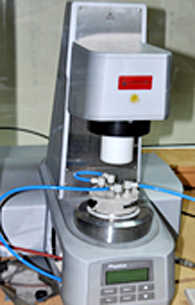
Characterization Equipment:Anton Paar Physica MCR301
Specification:
| Technical Data | Unit | MCR 302 |
| Bearing | Air | |
| EC motor | Yes | |
| Maximum torque | mNm | 200 |
| Min. torque, rotation | nNm | 1 |
| Min. torque, oscillation | nNm | 0.5 |
| Angular deflection (set value) |
µrad | 0.05 to ∞ |
| Min. angular velocity | rad/s | 10-9 |
| Max. angular velocity | rad/s | 314 |
| Max. speed | 1/min | 3000 |
| Min. angular frequency | rad/s | 10-7 |
| Max. angular frequency | rad/s | 628 |
| Normal force range | N | 0.005-50 |
| Normal force resolution | mN | 0.5 |
| Max. temperature range | °C | -150 to +1000 |

Characterization Equipment:
Nikon eclipse LV100 Industrial MicroscopeSpecification:
Model name: ECLIPSE LV100D
Magnification: 5x0.15, 10x0.30,
20x0.45, 50x0.80, 100x0.90 (LO plan fluor)
Optical system: CFI60 optical system
Illumination: Lamp ratings: 12 VDC, 50 W halogen lamp
Specified lamp: LV-HL50W 12V 50W halogen lamp
Specified lamp house: LV-LH50PC
Focusing mechanism: Stroke: 30 mm
Coarse focus knob: 14 mm/revolution
Fine focus knob: 0.1 mm/revolution
Eyepiece: 10x, field number: 22, 25
Operating environment: Temp: 0°C to +40°C
Relative humidity: 85% RH max.
Altitude: 2000 m max.
Pollution degree: Degree 2
Relevant Information (if any):
Faculty: Dr. J. Ramkumar (Lab Coordinator)
Staff: Mr. Sanjeev Kumar Verma,
Mr. Atul Kumar Gangwar
Contact Person: Mr. Sanjeev Kumar Verma
Location: NL-1-115A Manufacturing Science Lab., ME, IIT Kanpur
Phone: 0512-259-7923
Email: This email address is being protected from spambots. You need JavaScript enabled to view it.
Highlights
- List of candidates from CFTI selected for provisional admission for PhD program in Mechanical Engineering for the session 2025-26-I.New
- Department of Mechanical Engineering, IIT Kanpur Presents 2nd Mechanical Sciences Young Investigators Meet MSYIM 2025 17-19 March 2025. Visit the website for more details: MSYIM 2025
- Guidelines for the Application of Institute Post Doctoral Fellows
- Applications invited for direct PhD students for the semester 2025-26-I. Last date of application February 20, 2025
- List of Selected candidates: Winter PG Admission 2024
- Candidates Shortlisted for Interview: Winter Admission PhD Programme 2024
- Dates for PhD winter admission 2024 written exam and interviews: November 27-28, 2024
- Reporting date of all new PG students: Jul 18 - 19, 2024
- Departmental Orientation of new PG Students: Jul 20, 2024, 2:30 PM onward, Venue: L16
- PhD admission (Round 2): Application form available here. Last date of application: 4th July 2024. Online written test: 7th July, 2024, Online/Offline Interviews: 10th July, 2024
- M.Tech. Admission (through COAP): Cutoff score, Vacancy and fee paid data
- Selected candidates for provisional admission in PhD programme
- Selected and WL candidates for MS(R) admission (Institute-sponsored category) Round 1
- Rolling advertisement for faculty recruitment





























